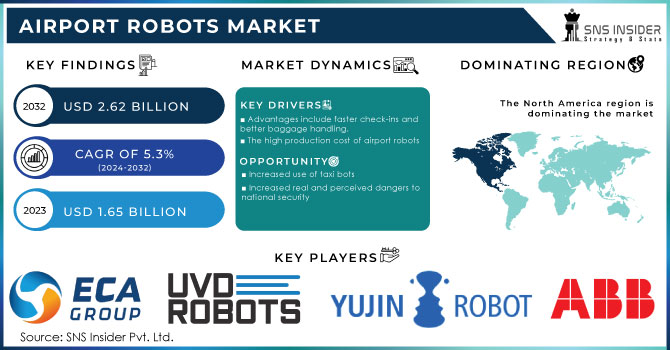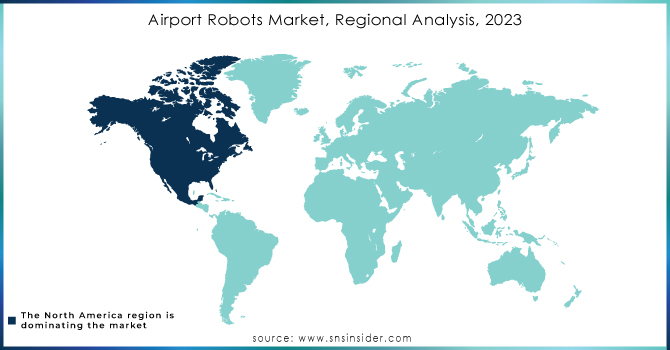Airport Robots Market Report Scope & Overview:
The Airport Robots Market size was USD 1.65 billion in 2023 and is expected to reach USD 2.62 billion by 2032, growing at a CAGR of 5.3% over the forecast period of 2024-2032.

To get more information on Airport Robots Market - Request Free Sample Report
As technology is utilized to engage with passengers and boost productivity, robots are becoming more prevalent in airport terminals. Many robots can learn and enhance their knowledge thanks to artificial intelligence and machine learning technologies. As technology advances, the robots will be able to provide more relevant information to passengers while also providing airport managers and airlines with significant operational benefits. Because of the increasing deployment of airport robots for cleaning services and security applications, the worldwide airport robots market has grown significantly in recent years. Furthermore, the increasing use of automation in technologies such as artificial intelligence and chat bots to manage airline bookings is expected to generate profitable prospects for the growth of the global airport robots market throughout the forecast period. Airport automation is becoming increasingly popular around the world. These robots are intended to provide concierge services, as well as handle security and check-ins. The increasing adoption of high technology robots to improve airport services is likely to boost market growth in the future.
MARKET DYNAMICS
KEY DRIVERS
-
Advantages include faster check-ins and better baggage handling.
-
The high production cost of airport robots
OPPORTUNITIES
-
Increased use of taxi bots
-
Increased real and perceived dangers to national security
CHALLENGES
-
Human-Robot Collaboration Problem are Associated together.
-
Challenge Impact Analysis
THE IMPACT OF COVID-19
The COVID-19 epidemic has changed many aspects of the aviation industry and markets. The outbreak of COVID-19 has led to the closure of several months and strict international and domestic tourism laws. As a result, the number of passengers is greatly reduced. According to IATA data, Asia Pacific and North American markets had a significant influence in March, with passenger fares plummeting by 71.5 percent. the purchase of new airport robots has also been halted during the violence as many airports have failed to generate significant revenue. This feature has led to limited investment in new purchases. However, in order to counteract the impact of COVID-19, many airport officials have planned to deploy fully autonomous robots. airport operations to reduce the spread of COVID-19 and the number of personnel hired to provide cleaning services or other floor management services. Shipping robots to the airport, passenger traffic lights, or cargo-carrying robots can reduce airport operating costs. In July 2020, Gerald R. Ford International Airport in Grand Rapids, Michigan announced the launch of a clean robot. This robot can clean an entire room in 10-15 minutes and use ultraviolet light to disinfect the surface. Human workers will not keep up with this rush.
The non-humanoid category will dominate the market. Based on kind, the market is divided into humanoid and non-humanoid segments.
In the base year, the non-humanoid segment dominated.
The non-humanoid type has a high percentage due to its widespread use in freight transportation, cargo loading and unloading, and baggage loading and unloading. The humanoid sector, on the other hand, is expected to develop at the fastest rate in the market throughout the forecast period. The appearance of a humanoid robot is credited with this expansion. This robot has a human-like appearance and can interact with human-made equipment and environments. These multitasking robots can operate in a variety of conditions. As a result, the demand for such robots to perform passenger services is expanding.
The global market is divided into terminal and land side applications. Boarding pass scanning, airport security and cleaning, passenger orientation, and airport baggage system are all part of the terminal sector. The terminal segment leads the market in the base year and is likely to do so throughout the entire forecast period. At the terminal, there is airport security and cleaning, a baggage system, boarding pass scanning, and passenger guidance. As a result, the terminal segment will increase rapidly from 2022 to 2028. This expansion can be due to the increasing use of robots for passenger navigation, airport security, and cleaning. The need for smart airport robots for smart auto parking applications is expected to drive considerable growth in the land side market throughout the forecast period.
Value Chain Analysis
The global airport robots market is categorized by application and geography, according to the most recent research report. The worldwide airport robotics industry is separated into two applications: landslide and terminal. The landslide part was subdivided into velvet parking. As these areas are open for parking and public use, the landslide sector represents for the majority of the airport robots industry share in 2019. Small robots have been sent to clean the land side areas. Velvet parking has recently gained popularity since robot parking not only saves time but also uses the best available places. These automatic parking technologies are being implemented at the world's busiest airports.
The worldwide airport robots market is divided into two segments based on terminal: airport security and boarding pass scanning. The terminal category accounts for the market's second highest share. To gain traction, airport terminals deploy robots to offer traveller with terminal information and guidance. Robots are built with artificial intelligence and facial recognition technology to detect dangers and alert security staff. Over the projection period, the boarding pass scanning segment is expected to increase significantly. Robots assist in scanning boarding passes and reducing overall check-in times. Furthermore, these airport robots transport the bags of passengers.
KEY MARKET SEGMENTTION
By End-User
-
Boarding Pass Scanning
-
Airport Baggage System
-
Passenger Guidance
-
Others
By Application
-
Land side
-
Terminal
By Type
-
Humanoid
-
Non-Humanoid
REGIONAL ANALYSIS
North America has become a leading player in this market. A large number of airports in the U.S. and the rapid adoption of state-of-the-art airport technology to improve passenger knowledge is expected to support market growth in North America. At the time of forecasting, the Asia Pacific region is expected to grow rapidly in markets. soon.In addition, the growing number of new airport and passenger design projects in India furthers the need for airport robots during global forecast. Due to growing business and leisure tourism, the demand for European airlines is growing. According to Airports Council International (ACI) Europe, the region's aviation industry is expected to grow by more than 54% in air travel between 2022 and 2028. This increase in shipping size is expected to arouse the interest of aviation authorities in spending more money to make existing facilities more modern. Global market will grow at a moderate pace due to increased investment in airport development in the UAE, Qatar, and Saudi Arabia.

Need any customization research on Airport Robots Market - Enquiry Now
REGIONAL COVERAGE:
-
North America
-
USA
-
Canada
-
Mexico
-
-
Europe
-
Germany
-
UK
-
France
-
Italy
-
Spain
-
The Netherlands
-
Rest of Europe
-
-
Asia-Pacific
-
Japan
-
south Korea
-
China
-
India
-
Australia
-
Rest of Asia-Pacific
-
-
The Middle East & Africa
-
Israel
-
UAE
-
South Africa
-
Rest of Middle East & Africa
-
-
Latin America
-
Brazil
-
Argentina
-
Rest of Latin America
-
KEY PLAYERS
The Major players are ECA Group, UVD Robots, YUJIN Robot Co., Ltd., ABB Ltd., Avidbots Corp., Cyberdyne Inc., LG Electronics Inc., SITA, SoftBank Corp., Stanley Robotics and other players
| Report Attributes | Details |
|---|---|
| Market Size in 2023 | US$ 1.65 Billion |
| Market Size by 2032 | US$ 2.62 Billion |
| CAGR | CAGR of 5.3% From 2023 to 2030 |
| Base Year | 2022 |
| Forecast Period | 2024-2032 |
| Historical Data | 2020-2022 |
| Report Scope & Coverage | Market Size, Segments Analysis, Competitive Landscape, Regional Analysis, DROC & SWOT Analysis, Forecast Outlook |
| Key Segments | • By End User (Airport Security, Boarding Pass Scanning, Airport Baggage System, Passenger Guidance, and Others) • By Application (Land side and Terminal) • By Type (Humanoid and Non-humanoid) |
| Regional Analysis/Coverage | North America (USA, Canada, Mexico), Europe (Germany, UK, France, Italy, Spain, Netherlands, Rest of Europe), Asia-Pacific (Japan, South Korea, China, India, Australia, Rest of Asia-Pacific), The Middle East & Africa (Israel, UAE, South Africa, Rest of Middle East & Africa), Latin America (Brazil, Argentina, Rest of Latin America) |
| Company Profiles | ECA Group, UVD Robots, YUJIN Robot Co., Ltd., ABB Ltd., Avidbots Corp., Cyberdyne Inc., LG Electronics Inc., SITA, SoftBank Corp., Stanley Robotics, and other players. |
| DRIVERS | • Advantages include faster check-ins and better baggage handling. • The high production cost of airport robots |
| OPPORTUNITIES | • Increased use of taxi bots • Increased real and perceived dangers to national security |

